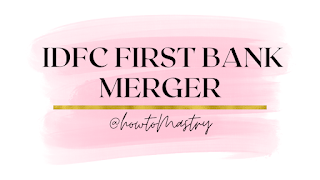IDFC First Bank Merger: A Milestone in Corporate Simplification and Growth
Learn about the recent merger between IDFC First Bank and IDFC Ltd, with a share exchange ratio of 155:100. This article explores the benefits of the merger, increased book value per share, and the streamlined regulatory compliances it offers.
IDFC First Bank Merger: A Boost for Growth and Simplification
The board members of IDFC First Bank have given their approval for the amalgamation of IDFC Ltd with the bank, marking a significant milestone in the financial industry. The share exchange ratio for the merger has been set at 155 equity shares of IDFC First Bank for every 100 equity shares of IDFC. This move aims to simplify the corporate structure, streamline regulatory compliances, and promote growth in both entities.
The Merger Details:
The proposed merger between IDFC First Bank and IDFC Ltd is expected to result in a 4.9% increase in the standalone book value per share of the bank, as per the financials of FY23. This calculation is based on the audited financials as of March 31, 2023. The merger ratio of 155:100 signifies the strong commitment to combining the strengths and resources of both entities.
Benefits of the Merger:
1. Simplification of Corporate Structure: The merger will consolidate IDFC First Bank, IDFC Financial Holding Company Ltd (IDFC FHCL), and IDFC Ltd into a single entity. This simplification aims to enhance operational efficiency and reduce administrative complexities.
Also Read: Effective Positive Parenting Tips in Hindi for a Stronger Bond with Your Child
2. Streamlined Regulatory Compliances: By merging into a single entity, the bank aims to streamline regulatory compliances and achieve better governance practices. This will contribute to a more robust and efficient banking system.
3. Increased Book Value per Share: The proposed merger is expected to result in a 4.9% increase in the standalone book value per share of IDFC First Bank. This signifies the growth potential and value creation for the bank's shareholders.
4. Diversified Shareholding: The merger will create an institution with diversified public and institutional shareholders, similar to other large private sector banks. This structure eliminates any promoter holding, promoting transparency and accountability.
Key Steps in the Merger Process:
To ensure a smooth and successful merger, several essential steps have been taken:
1. Fairness Opinion and Share Exchange Ratio: IDFC Ltd and IDFC FHCL appointed Axis Capital Ltd to provide a fairness opinion on the share exchange ratio for the merger. The final ratio was determined as 155:100, reflecting a favorable agreement.
2. Corporate Simplifications: All stages of corporate simplifications have been completed by the involved companies. The amalgamation with IDFC First Bank Limited is the next and final step in this process, scheduled to be completed within the current financial year, subject to unforeseen circumstances.
3. Valuation and Legal Due Diligence: SSPA & Co, Chartered Accountants, was appointed as the registered valuer to recommend the fair share exchange ratio. Cyril Amarchand Mangaldas, a renowned law firm, conducted legal due diligence and assisted in drafting and finalizing the scheme of amalgamation and filing regulatory applications.
Negative Impact on Investors:
1. Share Dilution: With the share exchange ratio of 155:100, existing IDFC Ltd shareholders will experience a dilution in their ownership stake. This dilution may lead to a decrease in the overall value of their holdings.
2. Uncertainty and Market Reaction: Mergers often introduce a period of uncertainty in the market. Investors may react to this uncertainty by selling their shares, leading to short-term volatility in stock prices.
3. Integration Challenges: Merging two entities involves complex integration processes, such as combining systems, cultures, and operations. If the integration is not executed smoothly, it may result in operational disruptions that could affect investor confidence.
4. Regulatory and Legal Risks: The merger process involves regulatory approvals and legal compliances. Delays or challenges in obtaining these approvals may impact the timeline and execution of the merger, potentially causing concerns for investors.
Financial Highlights:
IDFC First Bank's deposit franchise has witnessed substantial growth, with a 4-year compound annual growth rate (CAGR) of 36%. By March 31, 2023, the bank's deposit franchise reached Rs. 1.36 lakh crore. Furthermore, the current account and savings account (CASA) ratio increased from 8.6% at the time of the merger with Capital First in December 2018 to 49.77% by March 2023.
Conclusion:
The amalgamation of IDFC First Bank and IDFC Ltd represents a significant step towards simplifying the corporate structure, enhancing regulatory compliance, and promoting growth. With the merger expected to increase the book value per share by 4.9%, the bank is poised for value creation and improved shareholder benefits. This strategic move aligns with the bank's vision to become a leading institution with diversified shareholders and no promoter holding.
Summarize:
The merger between IDFC First Bank and IDFC Ltd, with a share exchange ratio of 155:100, is set to simplify the corporate structure, streamline regulatory compliances, and increase the book value per share by 4.9%. This strategic move aims to create a robust banking system, with diversified shareholders and improved governance practices.

No comments